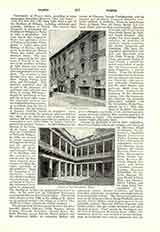

UNIVERSITY OF PADUA dates, according to some anonymous chronicles (Muratori, “Rer. Ital. Script.”, VIII, 371, 421, 459, 736), from 1222, when a part of the Studium of Bologna, including professors and students, withdrew to Padua. The opinion that Frederick II transferred the Studium of Bologna to Padua in 1241 is groundless. But even before this emigration there were professors of law at Padua, as Gerardus Pomadellus (c. 1165), afterwards Bishop of Padua; furthermore, his predecessor, Bishop Carzo, was called sacrorum canonurn doctor. The contract proposed by the commune of Vercelli to the Rectors of the students of Padua in 1228 shows that besides both laws and dialectics, medicine and grammar were taught there. The students were divided into four nationalities: French, Italian, German, and Provencal. This contract stipulated that all or part of the university (14 professors and sufficient students to occupy 500 houses) should be transferred to Vercelli for at least eight years. The university, however, was not suspended on that account, as is evident from the Life of St. Antonio. But the tyranny of Ezzelino (1237-56) caused its decadence. From 1260 it revived under the commune which established the rights of the professors and students, and the salaries (300 lire for legists and 200 for canonists); the examinations were held before the bishop, who also granted the teachers’ licences. In 1274 Padua had the decrees of the Council of Lyons, equal with the Universities of Paris and Bologna. In 1282, on account of certain communal laws against the clergy and the university, Nicholas IV threatened to deprive Padua of its Studium, but the commune relented, and the Studium acquired great renown, rivalling Bologna, especially in jurisprudence. From the beginning of the fourteenth century the school of medicine was also famous. The professors in this faculty introduced Averroism in philosophy.
The theological faculty was instituted by Urban V in 1363. In the same year the Collegium Tornacense was founded, the first of its kind in Padua. There were other institutes from 1390, as the college of St. Marco for six medical students, the college of Cardinal Pileo disciple Johann Muller, called Regiomontanus; in the (1420) for twenty (afterwards twelve) students.
The professors of this first period included the jurisconsults, Alberto Galeotto, Guido Suzzara, Jacopo d’Arena, Riccardo Malombra, Albrado Ponte, Rolando Piazzola, Jacopo Belvisio, Bartol Saliceti, and the celebrated Baldo: the canonists, Ruffino and
Jacopo da Piacenza, Lapoda Castiglionchio, and the canonist and theologian, Francesco Zabarella, afterwards cardinal; in medicine, Bruno da Longoburgo, Pietro d’Albano, Dino del Garbo, Jacopo and Giovanni Dondi (also excellent mechanicians), Marcilio, Giovanni and Guglielmo Santa Sofia, Jacopo da Forlè, and Biagio Pelacani. Philosophy was often taught, as elsewhere, by professors of medicine, mostly averroists, like Petrus Aponensis and Mundinus. The most distinguished philosophers who were not physicians were Pier Paolo Vergerio (1349-1414), afterwards Bishop of Capo d’Istria, a learned humanist and student of antiquity; the Franciscan, Antonio Trombetta, a famous Scotist. From the fifteenth century there were in theology and metaphysics two courses, one Thomistic, with professors preferably Dominican, and the other Scotist, with professors chiefly from the Friars Minor. Famous in the beginning of the sixteenth century were the controversies between the averroist philosopher, Achillini, and the Alexandrist, Pietro Pomponazzi (q.v.). The doctrines of the latter (who had gone to Bologna), especially on the soul were opposed, among others, by Agostino Nifo, another professor of philosophy at Padua. The humanist Girolamo Fracastoro taught philosophy there.
Among the professors of letters were: Rolandino, historian of Padua (thirteenth century), and Giovannida Ravenna, friend of Petrarch; the humanists Gosparino Barzizi, Francisco Filelfo, Vittorino da Feltre, a distinguished pedagogical writer and educator, Lauro Quirino; the Greeks Demetrio Chalcocondylas, Alessandro Zenos, Nicolas Leonicos, Marino Becichem, Romolo Amasacus, and Nicolo Caliachius; Giovanni Fascolus, Francesco Robortellos, the historian Sigonius, the great French Latinist Marc. Ant. Muretus, Justus Lipsius, and the great Latin lexicographers of the eighteenth century, Jacopus Faciolatus, and Egidio Forcellini. Astronomy, or astrology, was taught already in the fourteenth century. The most noted professors were, in the fifteenth century, Georg Pearbach, and his disciple Johann Müller, called Regiomontanus; in the sixteenth century, Giovanni Battista Capuano and Galileo Galilei, who also taught mechanics and other physical sciences. Chief among the theologians was the French Dominican Hyacinthe Serry (1698), who introduced there the new method of basing theology more on Scriptural and patristic arguments than on philosophical speculations, in which he encountered much opposition from the Conventual Fra Nicola Buico. Among the jurisconsults, after the closing of the university (1509-17), were the canonist Menochius, Alciatus, Lancelotti, and Pancirolo, famous also for his knowledge of Roman antiquities.
A characteristic of the University of Padua, even in the eighteenth century, was its internationalism, as seen from the list of professors about Facciolati; it was attended especially by Germans. When Venice passed under Austrian domination (1814) the university was transformed, like that of Pavia. At present it has the ordinary four faculties, besides a school of applied engineering and a school of pharmacy and obstetrics. Various astronomical institutes, bacteriological, physiological, hygienic, and pathological; chemical, physical, and geodetic laboratories; an anthropological museum; a botanical garden; and an astronomical observatory complete the equipment of the university. It has 128 chairs, 68 professors, 20 paid, and 107 private, tutors. In 1906, there was established near the university an institution for the education of Catholic young men. University education in Italy is strictly governmental, and without it all professional possibilities are closed to young men. At some seats of learning, Catholic Clubs were started to help them against the peril to their faith and morals, but they failed. The small Pensionata, situated in the neighborhood of Padua, between the Basilica and the church of Sta. Juliana, was transformed into a large establishment. The students attend a weekly conference which treats of points of faith affecting modern conditions of life and science.
U. BENIGNI

